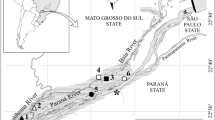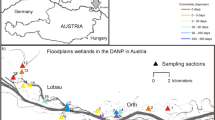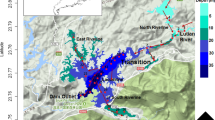Abstract
The maintenance of biodiversity in dynamic landscapes can be explained through the unifying concept of the metacommunity, an ecological system with a changing structure that arises from both the biotic features of its component species and from changing temporal processes. We evaluated the relative importance of environmental factors and spatial factors on the structure of metacommunities of zooplankton in a Neotropical floodplain system, in relation to hydrological dynamics and potential connections among lakes. Zooplankton was sampled from 16 to 22 shallow lakes during droughts and floods in two hydrologically contrasting years. Copepods appeared to be more limited by their dispersal potential, while testate amoebae and rotifers seemed to be controlled mostly by environmental variables. These findings stress the importance of the species sorting metacommunity paradigm for groups with the smallest propagules and adult body sizes. The importance of environmental factors rather than spatial factors was apparent during floods, likely due to the facilitation of animal dispersal by floods. Our results demonstrate that the importance of these factors depends on both the functional traits of major zooplankton groups and the hydrological dynamics of the region.







Similar content being viewed by others
References
Agostinho, A. A., S. M. Thomaz & L. C. Gomes, 2004a. Threats for biodiversity in the floodplain of the Upper Paraná River: effects of hydrological regulation by dams. Ecohydrology & Hydrobiology 4: 255–256.
Agostinho, A. A., L. C. Gomes, S. Veríssimo & E. K. Okada, 2004b. Flood regime, dam regulation and fish in the Upper Paraná River: effects on assemblage attributes, reproduction and recruitment. Reviews in Fish Biology and Fisheries 14: 11–19.
Algarte, V. M., L. Rodrigues, V. L. Landeiro, T. Siqueira & L. M. Bini, 2014. Variance partitioning of deconstructed periphyton communities: does the use of biological traits matter? Hydrobiologia 722: 279–290.
Allen, C. R., A. S. Garmestani, T. D. Havlicek, P. A. Marquet, G. D. Peterson, C. Restrepo, C. A. Stow & B. E. Weeks, 2006. Patterns in body mass distributions: sifting among alternative hypotheses. Ecology Letters 9: 630–643.
Baas Becking, L. G. M., 1934. Geobiologie of inleiding tot de milieukunde. W.P. Van Stockum & Zoon, The Hague.
Baranyi, C., T. Hein, C. Holarek, S. Keckeis & F. Schiemer, 2002. Zooplankton biomass community structure in a Danube River floodplain system: effects of hydrology. Freshwater Biology 47: 473–482.
Beisner, B. E., P. R. Peres-Neto, E. S. Lindström, A. Barnett & M. L. Longhi, 2006. The role of environmental and spatial processes in structuring lake communities from bacteria to fish. Ecology 87: 2985–2991.
Bles, E. J., 1929. Arcella. A study in cell physiology. The Quarterly Journal of Microscopical Science 72: 527–648.
Borcard, D. & P. Legendre, 2002. All-scale spatial analysis of ecological data by means of principal coordinates of neighbour matrices. Ecological Modelling 153: 51–68.
Borcard, D., P. Legendre & P. Drapeau, 1992. Partialling out the spatial component of ecological variation. Ecology 73: 1045–1055.
Borcard, D., F. Gillert & P. Legendre, 2011. Numerical Ecology with R. Springer, New York.
Bottrell, H. H., A. Duncan, Z. M. Gliwicz, E. Grygierek, A. Herzig, A. Hillbricht-Ilkowska, H. Kurasawa, P. Larsson & T. Weglenska, 1976. A review of some problems in zooplankton production studies. Norwegian Journal of Zoology 24: 419–456.
Brando, P. M., M. T. Coe, R. DeFries & A. A. Azevedo, 2013. Ecology, economy and management of an agroindustrial frontier landscape in the southeast Amazon. Philosophical Transactions of the Royal Society B 368: 20120152.
Cáceres, C. E. & D. A. Soluk, 2002. Blowing in the wind: a field test of overland dispersal and colonization by aquatic invertebrates. Oecologia 131: 402–408.
Carmouze, J. P., 1994. O metabolismo dos ecossistemas aquáticos: fundamentos teóricos, métodos de estudo e análises químicas. Edgard Blucher, São Paulo.
Chick, J., A. Levchuk, K. Medley & J. H. Havel, 2010. Underestimation of rotifer abundance a much greater problem than previously appreciated. Limnology and Oceanography: Methods 8: 79–87.
Cohen, G. M. & J. B. Shurin, 2003. Scale-dependence and mechanisms of dispersal in freshwater zooplankton. Oikos 103: 603–617.
Cottenie, K. & L. De Meester, 2003. Connectivity and cladoceran species richness in a metacommunity of shallow lakes. Freshwater Biology 48: 823–832.
Cottenie, K., E. Michels, N. Nuytten & L. De Meester, 2003. Zooplankton metacommunity structure: regional vs. local processes in highly interconnected ponds. Ecology 84: 991–1000.
De Bie, T., L. De Meester, L. Brendonck, K. Martens, B. Goddeeris, D. Ercken, H. Hampel, L. Denys, L. Vanhecke, K. Van der Gucht, J. Van Wichelen, W. Vyverman & S. A. J. Declerck, 2012. Body size and dispersal mode as key traits determining metacommunity structure of aquatic organisms. Ecology Letters 15: 740–747.
Deflandre, G., 1928. Le genre Arcella Ehrenberg. Archiv für Protistenkunde 64: 152–287.
Deflandre, G., 1929. Le genre Centropyxis Stein. Archiv für Protistenkunde 67: 322–375.
Dias, J. D., C. C. Bonecker & M. R. Miracle, 2014. The rotifer community and its functional role in lakes of a Neotropical floodplain. International Review of Hydrobiology 99: 72–83.
Dudgeon, D., 2003. The contribution of scientific information to the conservation and management of freshwater biodiversity in tropical Asia. Hydrobiologia 500: 295–314.
Elmoor-Loureiro, M. A. L., 1997. Manual de identificação de cladóceros límnicos do Brasil. Editora Universa, Brasília.
Fernandes, A. P. C., L. S. M. Braghin, J. Nedli, F. Palazzo, F. A. Lansac-Tôha & C. C. Bonecker, 2012. Passive zooplankton community in different environments of a Neotropical floodplain. Acta Scientiarum Biological Sciences 34: 413–418.
Fernandes, I. M., R. Henriques-Silva, J. Penha, J. Zuanon & P. R. Peres-Neto, 2014. Spatiotemporal dynamics in a seasonal metacommunity structure is predictable: the case of floodplain-fish communities. Ecography 37: 464–475.
Fontaneto, D., 2011. Biogeography of Microscopic Organisms. Is Everything Small Everywhere?. The University of Chicago Press, Chicago.
Frisch, D., K. Cottenie, A. Badosa & A. Green, 2012. Strong spatial influence on colonization rates in a pioneer zooplankton metacommunity. PLoS One 7: 1–10.
Gauthier-Lièvre, L. & R. Thomas, 1958. Le genre Difflugia, Pentagonia, Maghrebia et Hoogenraadia (Rhizopodes Testacès) en Afrique. Archiv für Protistenkunde 103: 1–370.
Gilpin, M. E. & I. A. Hanski, 1991. Metapopulation Dynamics: Empirical and Theoretical Investigations. Academic Press, London.
Giné, M. F., H. Bergamin, E. A. Zagatto & B. F. Reis, 1980. Simultaneous determination of nitrate and nitrite by flow injection analysis. Analytica Chimica Acta 114: 191–197.
Golterman, H. L., R. S. Clymo & M. A. M. Ohstad, 1978. Methods for Physical and Chemical Analysis of Freshwaters. Blackwell, Oxford.
Gonzalez, A., 2009. Metacommunities: Spatial Community Ecology. Wiley, Chichester.
Górski, K., J. J. De Leeuw, H. V. Winter, D. Vekhov, A. E. Minin, A. D. Buijse & L. A. J. Nagelkerke, 2011. Fish recruitment in a large, temperate floodplain: the importance of annual flooding, temperature and habitat complexity. Freshwater Biology 56: 2210–2225.
Hájek, M., J. Rolecek, K. Cottenie, K. Kintrová, M. Horsák, A. Poulícková, P. Hájková, M. Fránková & D. Díte, 2011. Environmental and spatial controls of biotic assemblages in a discrete semi-terrestrial habitat: comparison of organisms with different dispersal abilities sampled in the same plots. Journal of Biogeography 38: 1683–1693.
Havens, K. E., J. R. Beaver, E. E. Manis & T. L. East, 2015. Inter-lake comparisons indicate that fish predation, rather than high temperature, is the major driver of summer decline in Daphnia and other changes among cladoceran zooplankton in subtropical Florida lakes. Hydrobiologia 750: 57–67.
Heino, J., 2013. The importance of metacommunity ecology for environmental assessment research in the freshwater realm. Biological Reviews 88: 166–178.
Heino, J., A. S. Melo, T. Siqueira, J. Soininen, S. Valanko & L. M. Bini, 2015. Metacommunity organisation, spatial extent and dispersal in aquatic systems: patterns, processes and prospects. Freshwater Biology 60: 845–869.
Hendrickx, F., J.-P. Maelfait, K. Desender, S. Aviron, D. Bailey, T. Diekotter, L. Lens, J. Liira, O. Schweiger, M. Speelmans, V. Vandomme & R. Bugter, 2009. Pervasive effects of dispersal limitation on within- and among community species richness in agricultural landscapes. Global Ecology and Biogeography 18: 607–616.
Holyoak, M., M. A. Leibold & R. D. Holt, 2005. Metacommunities: Spatial Dynamics and Ecological Communities. The University of Chicago Press, Chicago.
Iglesias, C., N. Mazzeo, M. Meerhoff, G. Lacerot, J. M. Clemente, F. Scasso, C. Kruk, G. Goyenola, J. García-Alonso, S. L. Amsinck, J. C. Paggi, S. José de Paggi & E. Jeppesen, 2011. High predation is of key importance for dominance of small-bodied zooplankton in warm shallow lakes: evidence from lakes, fish exclosures and surface sediments. Hydrobiologia 667: 133–147.
Jenkins, K. M. & A. J. Boulton, 2003. Connectivity in a dryland river: short-term aquatic microinvertebrate recruitment following floodplain inundation. Ecology 84: 2708–2723.
José De Paggi, S. B. & J. C. Paggi, 2008. Hydrological connectivity as a shaping force in the zooplankton community of two lakes in the Paraná River floodplain. International Review of Hydrobiology 93: 659–678.
Junk, W. J., P. B. Bayley & R. E. Sparks, 1989. The flood pulse concept in river-floodplain systems. Canadian Special Publication of Fisheries and Aquatic Sciences 106: 110–127.
Koroleff, K. J. H., 1976. Determination of ammonia. In Grasshoff, E. & E. Kremling (eds), Methods of Seawater Analysis. Verlag Chemie, Weinheim: 117–181.
Koste, W., 1978. Rotatoria die Rädertiere Mitteleuropas begründet von Max Voight. Monogononta. Gebrüder Borntraeger, Berlin.
Landeiro, V. L., W. E. Magnusson, A. S. Melo, H. V. Espírito-Santo & L. M. Bini, 2011. Spatial eigenfunction analyses in stream networks: do watercourse and overland distances produce different results? Freshwater Biology 56: 1184–1192.
Lansac-Tôha, F. A., C. C. Bonecker, L. F. M. Velho, N. R. Simões, J. D. Dias, G. M. Alves & E. M. Takahashi, 2009. Biodiversity of zooplankton communities in the Upper Paraná River floodplain: interannual variation from long-term studies. Brazilian Journal of Biology 69: 539–549.
Legendre, P. & L. Legendre, 1998. Numerical Ecology. Elsevier, Amsterdam.
Legendre, P. & E. D. Gallagher, 2001. Ecologically meaningful transformations for ordination of species data. Oecologia 129: 271–280.
Leibold, M. A., 2011. The metacommunity concept and its theoretical underpinnings. In Scheiner, S. M. & M. R. Willig (eds), The Theory of Ecology. University Chicago Press, London: 163–183.
Leibold, M. A. & J. Norberg, 2004. Biodiversity in metacommunities: plankton as complex adaptive systems? Limnology and Oceanography 49: 1278–1289.
Leibold, M. A., M. Holyoak, N. Mouquet, P. Amarasekare, J. M. Chase, M. F. Hoopes, R. D. Holt, J. B. Shurin, R. Law, D. Tilman, M. Loreau & A. Gonzalez, 2004. The metacommunity concept: a framework for multi-scale community ecology. Ecology Letters 7: 601–613.
Logue, J. B., N. Mouquet, H. Peter & H. Hillebrand, 2011. Empirical approaches to metacommunities: a review and comparison with theory. Trends in Ecology and Evolution 26: 482–491.
Mackereth, F. J. H., J. Heron & J. F. Talling, 1978. Water analysis: some revised methods for limnologists. Freshwater Biological Association 36: 1–120.
Matsumura-Tundisi, T., 1986. Latitudinal distribution of Calanoida copepods in freshwater aquatic systems of Brazil. Brazilian Journal of Biology 46: 527–553.
Michels, E., K. Cottenie, L. Neys & L. De Meester, 2001. Zooplankton on the move: first results on the quantification of dispersal of zooplankton in a set of interconnected ponds. Hydrobiologia 442: 117–126.
Millennium Ecosystem Assessment, 2005. Ecosystems and Human Well-being: Current State and Trends. Island Press, Washington.
Neiff, J. J., 1990. Ideas para la interpretación ecológica del Paraná. Interciencia 15: 424–441.
Neiff, J. J., 1995. Large rivers of South America: toward the new approach. Verhandlungen des Internationalen Verein Limnologie 26: 167–180.
Ng, I. S. Y., C. M. Carr & K. Cottenie, 2009. Hierarchical zooplankton metacommunities: distinguishing between high and limiting dispersal mechanisms. Hydrobiologia 619: 133–143.
Ning, N. S. P. & D. L. Nielsen, 2011. Community structure and composition of microfaunal egg bank assemblages in riverine and floodplain sediments. Hydrobiologia 661: 211–221.
O’Malley, M. A., 2007. The nineteenth century roots of ‘everything is everywhere’. Nature Reviews 5: 647–651.
Padial, A. A., F. Ceschin, S. A. J. Declerck, L. De Meester, C. C. Bonecker, F. A. Lansac-Tôha, L. Rodrigues, L. C. Rodrigues, S. Train, L. F. M. Velho & L. M. Bini, 2014. Dispersal ability determines the role of environmental, spatial and temporal drivers of metacommunity structure. PLoS One 9: e111227.
Peres-Neto, P. R., L. Legendre, S. Dray & D. Borcard, 2006. Variation partitioning of species data matrices: estimation and comparison of fractions. Ecology 87: 2614–2625.
Petsch, D. K., G. D. Pinha, J. D. Dias & A. M. Takeda, 2015. Temporal nestedness in Chironomidae and the importance of environmental and spatial factors in species rarity. Hydrobiologia 745: 181–193.
Reid, J. W., 1985. Chave de identificação e lista de referências bibliográficas para as espécies continentais sulamericanas de vida livre da ordem Cyclopoida (Crustacea, Copepoda). Boletim de Zoologia 9: 17–143.
Core Team, R., 2014. R: A Language and Environment for Statistical Computing. R Foundation for Statistical Computing, Vienna.
Schönborn, W., 1962. Über planktismus und ziklomorphose bei Difflugia limnetica (Levander) Pénard. Limnologica 1: 21–34.
Segers, H., 1995. Rotifera: the Lecanidae (Monogonta). Guides to the identification of the micro invertebrates of the continental water of the world. SPB Academic, The Hague.
Simões, N. R., F. A. Lansac-Tôha, L. F. M. Velho & C. C. Bonecker, 2012. Intra and inter-annual structure of zooplankton communities in floodplain lakes: a long-term ecological research study. Revista de Biología Tropical 60: 1819–1836.
Simões, N. R., J. D. Dias, C. M. Leal, L. S. M. Braghin, F. A. Lansac-Tôha & C. C. Bonecker, 2013. Floods control the influence of environmental gradients on the diversity of zooplankton communities in a Neotropical floodplain. Aquatic Sciences 75: 607–617.
Soininen, J., M. Kokocinski, S. Estlander, J. Kotanen & J. Heino, 2007. Neutrality, niches, and determinants of plankton metacommunity structure across boreal wetland ponds. Ecoscience 14: 146–154.
Suzuki, H. I., A. A. Agostinho, D. Bailly, M. F. Gimenes, H. F. Júlio-Junior & L. C. Gomes, 2009. Inter-annual variations in the abundance of young-of-the-year of migratory fishes in the Upper Paraná River floodplain: relations with hydrographic attributes. Brazilian Journal of Biology 69: 649–660.
Symons, C. C. & S. E. Arnott, 2013. Regional zooplankton dispersal provides spatial insurance for ecosystem function. Global Change Biology 19: 1610–1619.
Teixeira, C., J. G. Tundisi & M. B. Kutner, 1965. Plankton studies in a mangrove: the standing-stock and some ecological factors. Boletim do Instituto Oceanográfico 24: 23–41.
Thomaz, S. M., L. M. Bini & R. L. Bozelli, 2007. Floods increase similarity among aquatic habitats in river-floodplain systems. Hydrobiologia 579: 1–13.
Vanormelingen, P., K. Cottenie, E. Michels, K. Muylaert, W. Vyverman & L. De Meester, 2008. The relative importance of dispersal and local processes in structuring phytoplankton communities in a set of highly interconnected ponds. Freshwater Biology 53: 2170–2183.
Vanschoenwinkel, B., S. Gielen, M. Seaman & L. Brendonck, 2008a. Any way the wind blows – frequent wind dispersal drives species sorting in ephemeral aquatic communities. Oikos 117: 125–134.
Vanschoenwinkel, B., S. Gielen, H. Vandewaerde, M. Seaman & L. Brendonck, 2008b. Relative importance of different dispersal vectors for small aquatic invertebrates in a rock pool metacommunity. Ecography 31: 567–577.
Vanschoenwinkel, B., S. Gielen, M. Seaman & L. Brendonck, 2009. Wind mediated dispersal of freshwater invertebrates in a rock pool metacommunity: differences in dispersal capacities and modes. Hydrobiologia 635: 363–372.
Vanschoenwinkel, B., A. Waterkeyn, M. Jocqué, L. Boven, M. Seaman & L. Brendonck, 2010. Species sorting in space and time – the impact of disturbance regime on community assembly in a temporary pool metacommunity. Journal of the North American Benthological Society 29: 1267–1278.
Winegardner, A. K., B. K. Jones, I. S. Y. Ng, T. Siqueira & K. Cottenie, 2012. The terminology of metacommunity ecology. Trends in Ecology & Evolution 27: 253–254.
Acknowledgments
The authors thank the Nupélia and the Graduate Program in Continental Aquatic Environments for logistical support, and PROEX/Capes. The PIAP–PELD LTER site provided financial support, and CNPq provided doctoral, post-doctoral, and Research Productivity scholarships. MM was supported by SNI-ANII and the L’Oréal-UNESCO Women in Science national award (Uruguay). Ciro Y. Joko (Centro de Ensino Unificado do Distrito Federal, Brazil) kindly furnished the drawing of the testate amoebae, rotifers, cladocerans, and copepods used in the conceptual model. We would like to thank the Ichthyology Lab/Nupélia for providing the fish database, particularly Professor Angelo A. Agostinho. We also thank Luc De Meester, Angelo A. Agostinho, Sidinei M. Thomaz, Luiz C. Gomes, and the anonymous reviewers for insightful comments that greatly improved the manuscript.
Author information
Authors and Affiliations
Corresponding author
Additional information
Handling editor: Karl E. Havens
Electronic supplementary material
Below is the link to the electronic supplementary material.
Rights and permissions
About this article
Cite this article
Dias, J.D., Simões, N.R., Meerhoff, M. et al. Hydrological dynamics drives zooplankton metacommunity structure in a Neotropical floodplain. Hydrobiologia 781, 109–125 (2016). https://doi.org/10.1007/s10750-016-2827-2
Received:
Revised:
Accepted:
Published:
Issue Date:
DOI: https://doi.org/10.1007/s10750-016-2827-2




